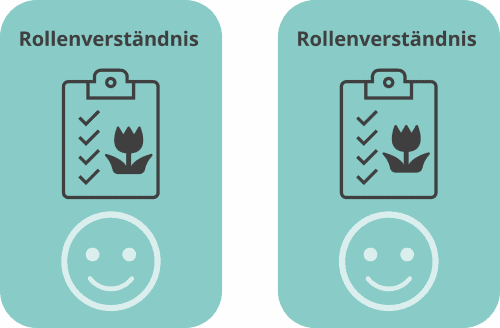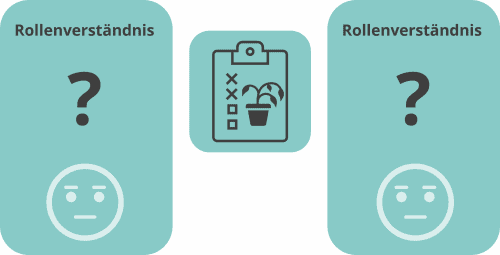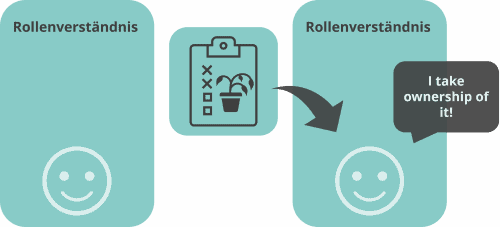31.05.2022
How do we bring agility into an organisation? Certainly not overnight. In order for the agile plant to grow and flourish sustainably in the organisation, it requires constant, organic implementation. Only with consistent application and intensification of the methodology can sustainable implementation be guaranteed. After all, we don’t want to reap our harvest for just one season. On the way from seedling to magnificent blossom, however, this little plant needs a special breeding ground – ownership for an agile understanding of roles. Often our gardeners still have a clear distribution of roles – if fertilised, watered, pruned, all conventional plants thrive.

Picture 1: Ownership as a foundation for an agile role understanding, The Company Journey Guides
A fixed understanding of roles
…only our agile plant is hanging its leaves tiredly – what has happened here?
Agile project management quickly pushes a fixed understanding of the roles of our gardeners to its limits. The team is confronted with new tasks at short intervals. And they cannot be clearly assigned to the predefined roles. The plant is still drooping its leaves, not to mention the blossom. Who is responsible here?
Suddenly, important tasks are not carried out. Delays occur. The process comes to a standstill. Blame begins to be apportioned. A, often not insignificant, part of the available capacities is occupied with the questions – Who should have been responsible here? Who is to blame? – instead of dealing with the urgently needed solutions.

Picture 2: Ownership as a foundation for an agile role understanding
The problem does not arise within roles, but in between. Mostly when tasks can no longer be clearly assigned to a role and responsibility is shirked. Why does no one take action even though our plant is withering?
- Agile project management makes it very difficult to identify all upcoming challenges in advance, to derive possible tasks and to assign them to concrete roles in the team due to short sprints and the specific input required from outside.
- There is no specialist in the team for the newly added tasks, as they were not foreseeable in advance, so someone has to familiarise themselves adequately with the topic.
- Often these new tasks represent an additional workload to the already planned range of tasks.
- Since no one feels directly responsible, the fulfilment is also followed up only carelessly or not at all.
How can ownership save our plant?
In an agile sense, a gardener, for example the person who first noticed the fading of the plant, would inform the team about the deviation in the project plan – we have proceeded as planned and still have to reckon with the loss of the crop. In the team, our gardener now gets the mandate to find a solution. He/she also takes ownership of the well-being of our plant. He/she follows the process beyond the mere presentation of a solution and is only satisfied when a respectable flower emerges. Problem solved, but how can we instruct our gardeners to do this?
Ownership cannot be assigned like roles – the behaviour only emerges through attitude. It requires intrinsic motivation to take on the plant. And to decide to holistically take responsibility for the identified task. The agile framework gives the freedom for this intrinsically made decision. But only ownership leads to the implementation of necessary measures. Even if these have not been specified in advance in any role, process or task description.
How do I create a corresponding attitude in my team?
Our everyday actions, how we approach the tasks we are given and how we continue successful patterns of action, have an impact on our personal satisfaction. Successes that can be traced back to self-determined action have a much more positive effect on our satisfaction and our own self-esteem than following work instructions. Agile principles and methods support autonomous action. In this sense, if we give the definition of roles, processes and tasks back to our gardeners step by step, we enable a sense of achievement based on self-determined decisions. At the same time, we reflect the closing of the process gap for the well-being of our plant back to the gardeners, who in the best case have their own claim for the fulfilment of the roles they have developed. Ownership as a foundation for an agile role understanding.

Picture 3: Ownership as a foundation for an agile role understanding
How do I know that ownership is functioning?
We leave the next withered plant that catches our eye and see whether it is being consolidated in the team. And whether someone will take care of it completely. If a healthy plant presents itself to us after a few days, the first seed has been planted. A fluid shift from employee to co-creator is initiated.
Ownership is not a matter of self-sufficiency, but requires constant care. Where no essential damage is to be expected, we can deliberately leave new tasks open. We give individuals the space to take on the solution. In this way, we prepare the ground for the consolidation of ownership and allow self-confidence to grow in the team.
Would ownership, as part of an agile mindset, also add value to your team? You can get a first appetizer in our TCJG To Go Agile Mindset Experience. We look forward to the exchange with you!
This blog was written by Patric Huchtemeier.
